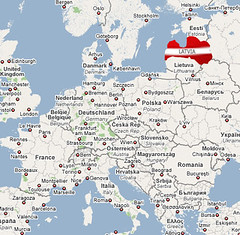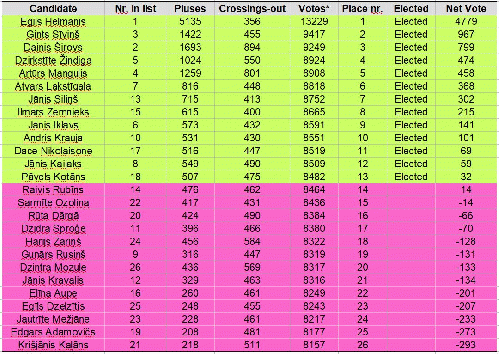First of all, the terminology deserves a few comments. It would appear that in Latvia, the ballot looks much like a typical Approval Voting (AV) ballot with just a single box next to each candidate's name. Voters are expected to cross off a name to express opposition to that candidate and to put a plus sign in the box to show support. And presumably when the voter does neither then that is treated as an abstention. I have reproduced the data from the reference in Table 1 below.
The first two columns show the names of the candidates and (I conjecture) their position on the ballots. The next two columns show the count of support and opposition votes, and the next column, labeled Votes, is described in a footnote as:
number of votes is equal to the number of valid ballots cast for the list minus the number of strike-outs of the name or surname of the candidate plus the number of "+" marks.
It should be noted that the number of valid ballots for this particular election is shown as 8450. In essence, the Vote column shows the net vote, but biased by the number of ballots submitted. This amounts to counting opposition as 0, abstention as 1 and support as 2. It is simply a matter of subtraction to compute the net vote from this column and I have taken the liberty of adding a final column to show the actual net vote.
This election seems to be for thirteen positions, perhaps in a legislature, and interestingly the winners turned out all to have positive net support; in fact only a single candidate with positive net support failed to win.
This data allows us to easily compare, for this election, AV with Balanced Approval Voting (BAV). In fact the Pluses column shows the vote-count for an AV election, so all we need to do is to sort the table so that the Pluses column is in decreasing order. This is shown in Table 2, which at first glance looks much the same as Table 1; both elect the same thirteen members. But notice that if the election had been for selecting eleven members instead of thirteen then there would be a serious difference in the outcome; at least in the view of Dace Nikolaisone and Janis Kaijaks.
But from the number of candidates in these elections it would appear that Latvia does not suffer under the two-party duopoly. And the most notable advantage of BAV is when there a two-party polarized electorate is either existing or developing. If Latvia were in that situation we should expect to see a great many more crossings-out by voters anxious to defeat members of the other party. In that case there would be a much more obvious difference in outcomes between AV and BAV elections.







